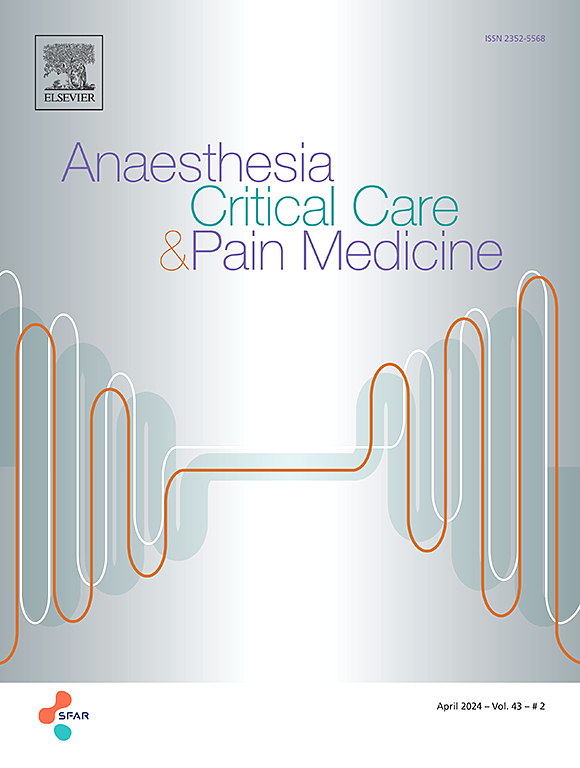机器人辅助通气外科危重患者早期活动(ROBEM-I)——一项随机、对照、结果评估、盲法的试点研究。
IF 4.7
3区 医学
Q1 ANESTHESIOLOGY
引用次数: 0
摘要
背景:人力资源短缺是阻碍机械通气ICU患者早期动员的关键障碍。机器人移动系统的最新进展为这一挑战提供了有希望的解决方案。目的:本研究评估了由单个医疗保健提供者提供的人工智能辅助机器人移动系统的可操作性,以及其对机械通气外科ICU患者的安全性、可行性和潜在益处。设计:随机对照先导研究。地点:2020年11月至2022年9月,德国柏林慈善医院(Universitätsmedizin)的五个外科icu。干预措施:与接受标准治疗的对照组相比,每天2次机器人辅助活动≥20分钟,持续5天。结果:在机器人辅助组中,没有人进行任何活动(0%),而没有人进行任何活动(0%)。结论:与标准组相比,机械通气危重患者的机器人辅助活动没有减少所需的医疗服务提供者,但增加了持续时间和频率,并显著降低了IL-6水平。试验注册:ClinicalTrials.gov,注册号NCT04423796。本文章由计算机程序翻译,如有差异,请以英文原文为准。
ROBotic-assisted Early Mobilization in ventilated surgical critically ill patients (ROBEM-I)—A randomized, controlled, outcome-assessor-blinded pilot study
Background
A shortage of human resources is a key barrier to the early mobilization of mechanically ventilated ICU patients. Recent advancements in robotic mobilization systems offer promising solutions to this challenge.
Objective(s)
This study assessed the operability of an AI-assisted robotic mobilization system by a single healthcare provider, along with its safety, feasibility, and potential benefits for mechanically ventilated surgical ICU patients.
Design
Randomized controlled pilot study.
Setting
Five surgical ICUs at Charité – Universitätsmedizin Berlin, Germany, November 2020 to September 2022.
Patients
Twenty critically ill patients requiring >24 h of mechanical ventilation.
Intervention(s)
Twice-daily robotic-assisted mobilization sessions ≥ 20 min over five days, compared to the control group receiving standard care.
Main outcome measures
Number of mobilization sessions conducted by a single person.
Results
In the robotic-assisted group, no mobility sessions were conducted by a single person (0%) vs. 26 (96%) in the control group (p < 0.001). Significant secondary outcomes included a mobilization duration of 41 min/day [IQR 36–47] in the intervention group vs. 19 min/day [IQR 13–21] in the control group (p < 0.001) and higher mobilization frequency, with two units/day [IQR 2−2] in the intervention group vs. 0.9 units/day [IQR 0.7–1.0] in the control group (p < 0.001). Interleukin-6 levels decreased significantly by −4.65 pg/mL [IQR −13.00–3.83] in the intervention group vs. an increase of 3.70 pg/ml [IQR −1.30–28.88] in the control group (p = 0.049).
Conclusions
Robotic-assisted mobilization in mechanically ventilated critically ill patients did not reduce required healthcare providers but increased the duration and frequency, and significantly reduced IL-6 levels compared to the standard group.
Trial registration
ClinicalTrials.gov, registration number NCT04423796.
求助全文
通过发布文献求助,成功后即可免费获取论文全文。
去求助
来源期刊

Anaesthesia Critical Care & Pain Medicine
ANESTHESIOLOGY-
CiteScore
6.70
自引率
5.50%
发文量
150
审稿时长
18 days
期刊介绍:
Anaesthesia, Critical Care & Pain Medicine (formerly Annales Françaises d''Anesthésie et de Réanimation) publishes in English the highest quality original material, both scientific and clinical, on all aspects of anaesthesia, critical care & pain medicine.
 求助内容:
求助内容: 应助结果提醒方式:
应助结果提醒方式:


